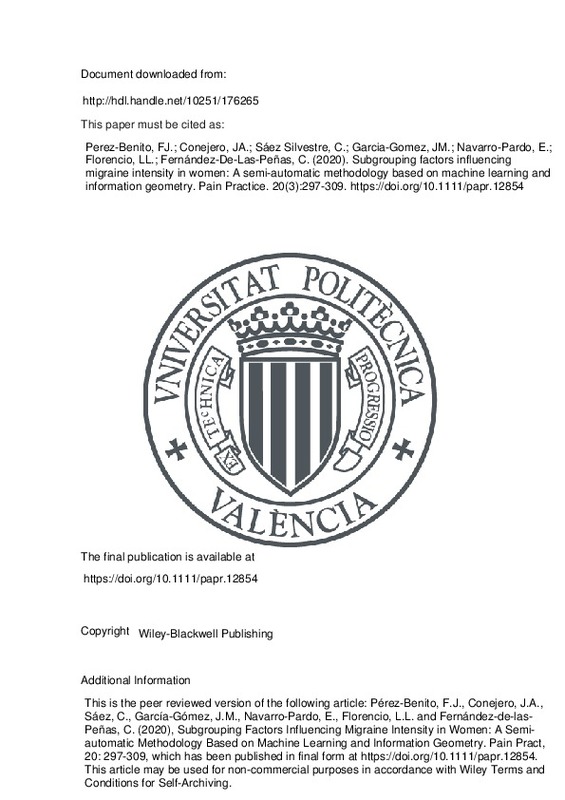JavaScript is disabled for your browser. Some features of this site may not work without it.
Buscar en RiuNet
Listar
Mi cuenta
Estadísticas
Ayuda RiuNet
Admin. UPV
Subgrouping factors influencing migraine intensity in women: A semi-automatic methodology based on machine learning and information geometry
Mostrar el registro sencillo del ítem
Ficheros en el ítem
| dc.contributor.author | Perez-Benito, Francisco Javier
|
es_ES |
| dc.contributor.author | Conejero, J. Alberto
|
es_ES |
| dc.contributor.author | Sáez Silvestre, Carlos
|
es_ES |
| dc.contributor.author | Garcia-Gomez, Juan M
|
es_ES |
| dc.contributor.author | Navarro-Pardo, Esperanza
|
es_ES |
| dc.contributor.author | Florencio, Lidiane L.
|
es_ES |
| dc.contributor.author | Fernández-de-las-Peñas, César
|
es_ES |
| dc.date.accessioned | 2021-11-05T14:06:58Z | |
| dc.date.available | 2021-11-05T14:06:58Z | |
| dc.date.issued | 2020-03 | es_ES |
| dc.identifier.issn | 1530-7085 | es_ES |
| dc.identifier.uri | http://hdl.handle.net/10251/176265 | |
| dc.description | This is the peer reviewed version of the following article: Pérez-Benito, F.J., Conejero, J.A., Sáez, C., García-Gómez, J.M., Navarro-Pardo, E., Florencio, L.L. and Fernández-de-las-Peñas, C. (2020), Subgrouping Factors Influencing Migraine Intensity in Women: A Semi-automatic Methodology Based on Machine Learning and Information Geometry. Pain Pract, 20: 297-309, which has been published in final form at https://doi.org/10.1111/papr.12854. This article may be used for non-commercial purposes in accordance with Wiley Terms and Conditions for Self-Archiving. | es_ES |
| dc.description.abstract | [EN] Background Migraine is a heterogeneous condition with multiple clinical manifestations. Machine learning algorithms permit the identification of population groups, providing analytical advantages over other modeling techniques. Objective The aim of this study was to analyze critical features that permit the differentiation of subgroups of patients with migraine according to the intensity and frequency of attacks by using machine learning algorithms. Methods Sixty-seven women with migraine participated. Clinical features of migraine, related disability (Migraine Disability Assessment Scale), anxiety/depressive levels (Hospital Anxiety and Depression Scale), anxiety state/trait levels (State-Trait Anxiety Inventory), and pressure pain thresholds (PPTs) over the temporalis, neck, second metacarpal, and tibialis anterior were collected. Physical examination included the flexion-rotation test, cervical range of cervical motion, forward head position while sitting and standing, passive accessory intervertebral movements (PAIVMs) with headache reproduction, and joint positioning sense error. Subgrouping was based on machine learning algorithms by using the nearest neighbors algorithm, multisource variability assessment, and random forest model. Results For migraine intensity, group 2 (women with a regular migraine headache intensity score of 7 on an 11-point Numeric Pain Rating Scale [where 0 = no pain and 10 = maximum pain]) were younger and had lower joint positioning sense error in cervical rotation, greater cervical mobility in rotation and flexion, lower flexion-rotation test scores, positive PAIVMs reproducing migraine, normal PPTs over the tibialis anterior, shorter migraine history, and lower cranio-vertebral angles while standing than the remaining migraine intensity subgroups. The most discriminative variable was the flexion-rotation test score of the symptomatic side. For migraine frequency, no model was able to identify differences between groups (ie, patients with episodic or chronic migraine). Conclusions A subgroup of women with migraine who had common migraine intensity was identified with machine learning algorithms. | es_ES |
| dc.language | Inglés | es_ES |
| dc.publisher | Wiley-Blackwell Publishing | es_ES |
| dc.relation.ispartof | Pain Practice | es_ES |
| dc.rights | Reserva de todos los derechos | es_ES |
| dc.subject | Migraine | es_ES |
| dc.subject | Random forest | es_ES |
| dc.subject | Machine learning | es_ES |
| dc.subject | Multisource variability | es_ES |
| dc.subject.classification | MATEMATICA APLICADA | es_ES |
| dc.subject.classification | FISICA APLICADA | es_ES |
| dc.title | Subgrouping factors influencing migraine intensity in women: A semi-automatic methodology based on machine learning and information geometry | es_ES |
| dc.type | Artículo | es_ES |
| dc.identifier.doi | 10.1111/papr.12854 | es_ES |
| dc.rights.accessRights | Abierto | es_ES |
| dc.contributor.affiliation | Universitat Politècnica de València. Departamento de Física Aplicada - Departament de Física Aplicada | es_ES |
| dc.contributor.affiliation | Universitat Politècnica de València. Departamento de Matemática Aplicada - Departament de Matemàtica Aplicada | es_ES |
| dc.contributor.affiliation | Universitat Politècnica de València. Instituto Universitario de Matemática Pura y Aplicada - Institut Universitari de Matemàtica Pura i Aplicada | es_ES |
| dc.description.bibliographicCitation | Perez-Benito, FJ.; Conejero, JA.; Sáez Silvestre, C.; Garcia-Gomez, JM.; Navarro-Pardo, E.; Florencio, LL.; Fernández-De-Las-Peñas, C. (2020). Subgrouping factors influencing migraine intensity in women: A semi-automatic methodology based on machine learning and information geometry. Pain Practice. 20(3):297-309. https://doi.org/10.1111/papr.12854 | es_ES |
| dc.description.accrualMethod | S | es_ES |
| dc.relation.publisherversion | https://doi.org/10.1111/papr.12854 | es_ES |
| dc.description.upvformatpinicio | 297 | es_ES |
| dc.description.upvformatpfin | 309 | es_ES |
| dc.type.version | info:eu-repo/semantics/publishedVersion | es_ES |
| dc.description.volume | 20 | es_ES |
| dc.description.issue | 3 | es_ES |
| dc.identifier.pmid | 31677218 | es_ES |
| dc.relation.pasarela | S\417387 | es_ES |
| dc.subject.ods | 03.- Garantizar una vida saludable y promover el bienestar para todos y todas en todas las edades | es_ES |







![[Cerrado]](/themes/UPV/images/candado.png)

